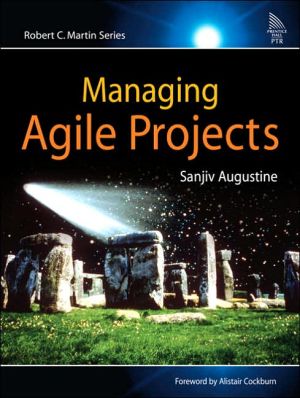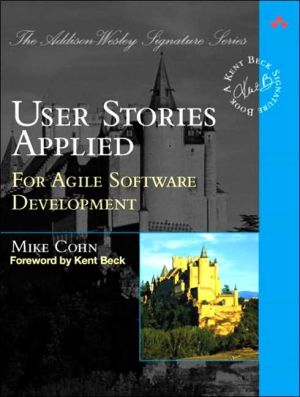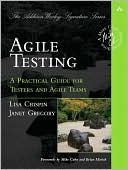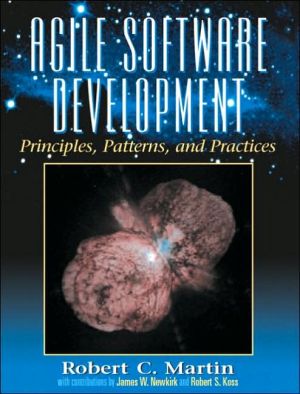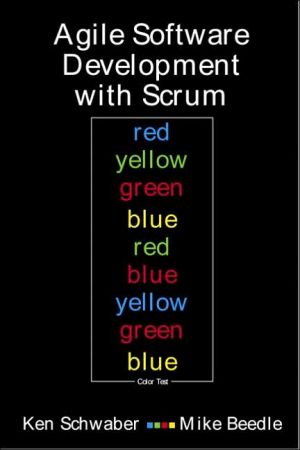Managing Agile Projects
PRAISE FOR MANAGING AGILE PROJECTS\ "In the hands of another, this class of material could become incoherent, but Sanjiv has enough intellectual power to ground his subject...Fans of APM and those who prefer new ideas as a catalyst for their management approach should find Managing Agile Projects rewarding."\ Wes Balakian, Chairman and Executive Advisor, PMI eBusiness SIG\ "I only wish I had read this book when I started my career in software product management, or even better yet, when I was...
Search in google:
PRAISE FOR MANAGING AGILE PROJECTS "In the hands of another, this class of material could become incoherent, but Sanjiv has enough intellectual power to ground his subject...Fans of APM and those who prefer new ideas as a catalyst for their management approach should find Managing Agile Projects rewarding."Wes Balakian, Chairman and Executive Advisor, PMI eBusiness SIG"I only wish I had read this book when I started my career in software product management, or even better yet, when I was given my first project to manage. In addition to providing an excellent handbook for managing with agile software development methodologies, Managing Agile Projects offers a guide to more effective project management in many business settings."John P. Barnes, former Vice President of Product Management at Emergis, Inc."The agile software development movement evolved from a half-dozen methodologies—Scrum, Adaptive, XP, Crystal—that while different, embodied a consistent set of values and similar practices. The agile project management movement is following the same path—strength through a blend of consistency and diversity. Sanjiv's book, Managing Agile Projects, adds both—consistency and diversity—to the concepts and practices of agile project management. His book is rich in ideas and practical advice. It is a wonderful addition to the growing literature about 'alternative' styles of project management."Jim Highsmith Sr. V.P. and Director Agile Software Development and Project Management Practice Fellow, Business Technology Council Cutter Consortium LLC, Arlington, MA"Here is an innovative approach to the management of agile projects, examining traditional project management practices that do not align well with new agile methodologies. Augustine's alternative approaches in regard to personnel, organization, and change make this a valuable resource for project managers as well as for the customer/product owner."Sydney H. Jammes, Retired C.I.A. Economist"Project management has almost become a new paradigm for getting work done in most corporations around the world. This book provides a long overdue synthesis of the diverse strategies and practices in project management. The holistic and organic approach in the book combines the people factor and task complexity elements nicely and delivers an easy-to-read narrative that should be a must-read for every manager."Tojo Thatchenkery, Professor of Organizational Learning, George Mason University"In our work with Sanjiv Augustine in New Zealand and Australia, he has always impressed me with his practical, lucid approach to the project management idea for our times—agile project management. This book captures the essence of that approach."Martyn Jones, Managing Director, Software Education Associates, Ltd."Rejoice! Sanjiv Augustine eloquently lays out a practical and elegant organic project management model for being innovative and delivering business value while maintaining a high quality of life. And in the process, he gives the world a proven alternative to mechanistic and rigid project management practices that have stifled software development and killed creativity. A brilliant piece of work."Doug DeCarlo, author, "eXtreme Project Management: Using Leadership, Principles and Tools to Deliver Value in the Face of Volatility""Sanjiv Augustine's informative new book, Managing Agile Projects, takes the mystery out of bringing about the successful completion of information technology projects. His innovative, clear, and sensible approach to the management of agile projects is a must-read for all members of the implementation team, from users to developers and from consultants to managers. This work is a major contribution to the field of project management."Martha C. Edmondson, Chief Financial Officer, African Development Foundation"This book significantly builds on and extends agile thinking."Jeff De Luca, creator of Feature Driven Development, www.nebulon.com"Sanjiv brings real world, interesting experiences to his topic and conveys the essentials of project management in the new era in a way that is both entertaining and enlightening. Busting the jargon and slicing through the marketing-speak, this book is an essential tool for anyone involved in development projects today."Shane Hastie, Chief Knowledge Engineer, Software Education Associates, Ltd."Managing Agile Projects extends the values and principles of more development-centric agile methodologies to project management, something essential to the creation and evolution of the truly agile organization. An excellent addition to the agile literature!"Steve Hayes, Professional Services Manager, Internet Business Systems"Agile Project Management, as outlined here, is a key component to building a software development organization that can effectively respond to changing market needs in a timely manner. "Madhu Garlanka, Senior Manager, eBusiness Application Development, Nextel Communications"Agile methods created by 'radicals' have matured into tools in common use in many organizations. Now that teams are using these methods on high-profile projects, executives are starting to ask, 'How can we manage these agile processes?' This book builds upon scientific research of complex adaptive systems to present a handbook for project managers and executives faced with the challenge of monitoring and controlling agile projects."Kevin J.J. Aguanno, PMP®, MAPM IBM Certified Senior Project Manager IBM Global Services, IBM Canada, Ltd."I read this book and immediately shared it with a manager of an XP team. It's got great ideas on how to manage agile teams using a 'light touch.'"William Wake, Independent Consultant"Agile Project Management, as outlined here, is a key component to building a software development organization that can effectively respond to changing market needs in a timely manner."—Madhu Garlanka, Sr. Manager, eBusiness Application Development, Nextel Communications"In the hands of another, this class of material could become incoherent, but Sanjiv has enough intellectual power to ground his subject....Fans of APM and those who prefer new ideas as a catalyst for their management approach should find Managing Agile Projects rewarding."—Wes Balakian, Chairman and Executive Advisor, PMI eBusiness SIGYour Hands-On, "In-the-Trenches" Guide to Successfully Leading Agile ProjectsAgile methods promise to infuse development with unprecedented flexibility, speed, and value—and these promises are attracting IT organizations worldwide. However, agile methods often fail to clearly define the manager's role, and many managers have been reluctant to buy in. Now, expert project manager Sanjiv Augustine introduces a proven management framework that addresses everything from team building to project control. Sanjiv bridges the disconnect between the assumptions and techniques of traditional and agile management, demonstrating why agility is better aligned with today's project realities, and how to simplify your transition: Customizing agile methods to your unique environment implementing full-life-cycle agility: from planning and coding to maintenance and knowledge transfer Learning how agile methods can scale to succeed in even the largest projects through a case study Managing the flow of customer value from one creative stage to the next Defining a high-value role for the manager in agile project environments Refocusing on outcomes—not rigid plans, processes, or controls Structuring and building adaptive, self-organizing "organic teams" Forming a guiding vision that aligns your team behind a common purpose Empowering your team with the information it needs to succeedWhether you're a technical or business manager, Managing Agile Projects gives you all the tools you need to implement agility in your environment—and reap its full benefits.
Preface\ When first placed in the position of leading an agile team nearly five years ago, I had precious little guidance to assist me in my job. This is the book that I wish I had then—I have endeavored to capture my subsequent experience and learning and present them in a form that is accessible to managers new to agile methodologies. Other managers more familiar with the agile landscape should enjoy it as well, albeit with the sense of the familiar. In the agile spirit of continuous learning and experimentation, I have drawn on many diverse disciplines to augment and to extend agile methodologies on my projects, including complexity theory, organizational learning, and Lean Thinking.\ Although there certainly are insights within that will benefit all those who are associated with agile project teams, this is primarily a book for agile managers—those individuals who have been gifted with, or are aspiring to, the privilege and responsibility of leading agile project teams. Some of you might inquire as to how this book differs from others on the agile market. I believe that Managing Agile Projects is different in these respects:\ \ It presents a holistic, systems view of project teams and the organizations that house them, especially their organizational learning aspects. It squarely addresses the role of the project manager on agile projects and presents practical ways to lead them.\ It acknowledges the necessary balance between management and leadership, and provides insights around leadership not found in other project management material.\ \ Although it draws primarily from XP, it incorporates several principles and practices from Scrum, Crystal, and Feature-Driven Development. It is wholly an "in-the-trenches" practitioner's view of the world of a project manager on agile projects.\ I have a passion for project management, and I have discovered that it is due in large part to the deep sense of satisfaction and fulfillment, fun, and ever-fresh learning that comes with working with a peer group of skilled individuals in delivering things of great value on agile teams. I trust that reading this book will help create some of those same experiences for you.\ © Copyright Pearson Education. All rights reserved.
Acknowledgments.Preface.Prelude–Project Phoenix–An APM Fable of Revival.Foreword By Alistair - Cockburn.Foreword by Robert C. Martin.Introduction.Prelude-Project Phoenix.1. Agile Project Management Defined.What Is Agility?What Is Agile Project Management?APM Principles.APM Practices.Summary.References.2. The Agile Manager.What Is the Agile Manager’s Role?Leadership of Management — What Does it Take?Shared Responsibilities.Other Management Roles.The Agile Manager’s Profile.Personal Values.Leadership Skills–Dealing with Change.Management Skills–Dealing with Complexity.Summary.3. Organic Teams-Part 1.Activities.Formal Team Structure.The Organic Complex Adaptive Systems Model.Activity: Identify the Project Community.Activity: Design a Holographic Formal Structure.Activity: Get Self-Disciplined Team Players.Summary.References.4. Organic teams-Part 2.Activities.Team Practice.Activity: Promote Software Craftsmanship.Activity: Foster Team Collaboration.Enterprise Integration.Activity: Form a Guiding Coalition.Activity: Cultivate Informal communities of Practice.Activity: Propose an Adaptive IT Enterprise.Summary.References.5. Guiding Vision.Activities.Team Vision.Activity: Evolve a Team Vision.Activity: Align the Team.Project Vision.Activity: Envision a Bold Future.Activity: Create and Maintain Shared Expectations.Activity: Discover Business Outcomes.Activity: Clearly Delineate Scope.Activity: Estimate Project Effort.Product Vision.Activity: Design a Vision Box.Activity: Develop an Elevator Statement.Summary.References.6. Simple Rules.Activities.Customizing the Rules to the Environment.Activity: Assess the Status Quo.Activity: Customize Methodology.Activity: Enlist the Team for Change.Implementing the Rules.Activity: Develop a Release Plan/Feature Backlog.Activity: Develop Iteration Plans/Task Backlogs.Activity: Facilitate Software Design, Coding, Testing and Deployment.Activity: Conduct Acceptance Testing.Activity: Manage the Software Release.Activity: Focus on Business Value.Summary.Reference.7. Open Information.Activities.Agile Practices.Activity: Collocate Team Members.Activity: Negotiate a Customer Representative Onsite.Activity: Practice Pairing.Activity: Encourage the Use of Information Radiators.Activity: Conduct a Stand-Up Meeting Daily.Information Cycle Time.Activity: Map the Project’s Value Stream.Transforming Exchanges.Activity: Encourage Feedback.Activity: Build Trust.Activity: Link Language with Action.Summary.References.8. Light Touch.Activities.Intelligent Control.Activity: Decentralize Control.Activity: Establish a Pull Task Management System.Activity: Manage the Flow.Activity: Use Action Sprints.Activity: Fit Your Style to the Situation.Activity: Support Roving Leadership.Activity: Learn to Go with the Flow.Whole-Person Recognition.Activity: Maintain Quality of Work Life.Activity: Build on Personal Strengths.Activity: Manage Commitments through Personal Interactions.Summary.References.9. Adaptive Leadership.Activities.Double-Loop Learning.Activity: Get Plus-Delta Feedback Daily.Activity: Monitor and Adapt the Simple Rules.Activity: Monitor the APM Practices.Activity: Conduct Regular Project Reflections.Activity: Conduct Scenario Planning.Embodied Leadership.Activity: Cultivate an Embodied Presence.Activity: Practice Embodied Learning.Summary.10. Transitioning from the Familiar.Transitions.Principle 1: Foster Alignment and Cooperation.Transition: Recognize That People Are the Longer-Term Project.Transition: Use the Organic CAS Model for Stability and Flexibility.Transition: Replace Software Engineering with Software Craftsmanship.Transition: Focus on Project Context, Not Content.Transition: Use Feature Breakdown Structures Instead of Work Breakdown Structures.Principle 2: Encourage Emergence and Self-Organization.Transition: Acknowledge That the Perfect Plan Is a Myth.Transition: Replace Predictive Planning with Adaptive Planning.Transition: Use Release Plans Instead of Gantt Charts.Transition: Stress Execution over Planning.Transition: Practice Time Pacing, Not Event Pacing.Transition: Practice Participatory, Not Authoritarian Decision Making.Transition: Coordinate Work Execution Through Commitments, Not Commands.Transition: Increase Personal Interactions, Especially Across Organizational Stovepipes.Principle 3: Institute Learning and Adaptation.Transition: Respond to Change with Adaptive, Not Corrective Action.Transition: Move from Lessons Learned to Project Reflections.Transition: Lead through Presence, Not Power.Summary.References.Afterword.Index.
